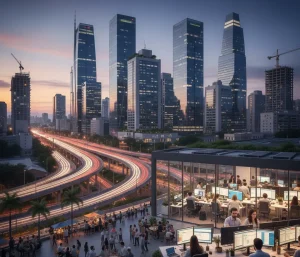The Worker’s Habitat: How Managed Workspaces Will Shape the Future of the Tech Office
Published on
In the middle of a pandemic, the tech industry was able to make work-from-home work. But is it sustainable? Zoom fatigue is real. The hordes of webinars and virtual events that dotted the early days of the pandemic are fading away. 24% of those surveyed by JLL want to work exclusively in the office, and 50% prefer a hybrid approach. More starkly, over 80% of high performers reported ‘missing their office greatly’ during the lockdown.
One of the most common reasons for this is the natural collaboration and serendipitous learning that a physical workplace enables — you don’t need to add yet another meeting on your colleague’s already crowded calendar to ask for help or make small talk. Moreover, McKinsey research finds that the frequent in-person contact that happens when employees are co-located helps build trust that’s critical to working together as a global team. Inspired employees want to get the job done efficiently, effectively, innovatively, competitively and sustainably. To achieve this, organizations need to create workplaces that go beyond work:
- Enabling an environment for networking, collaboration and collective innovation
- Building a physical workspace that embodies the organizational culture
- Creating a place that is uniquely representative of the brand and what it stands for
- Building a workspace that is safe, secure and smart
Managed Workspaces: The Real Estate Goldilocks Zone
Paradoxically, as the acceptance of work-from-home or work-from-anywhere in a globally distributed team grows, the longing for emotional engagement, connection and collaboration at the workplace also increases. The biggest challenge for operations leaders is in finding the goldilocks zone between the two. A managed workspace is the best of both worlds solution to the operations leaders conundrum.
Simply put, a managed office is a customized office space, in which a third-party vendor makes the CapEx investment, builds and manages it for you, so you can focus on your core competency.
Unlike the traditional owned or leased office spaces, managed workspaces are cost-efficient, flexible, scalable, agile and perfectly suited for the post-pandemic world.
Customizability: The most significant difference between a co-working space and a managed workspace is customizability. With an enterprise model managed workspace, you can customize your office, have your own reception/mailroom etc., having complete control over your organizational culture and practices. Whether you’re an athleisure brand that needs an in-house Yoga studio or a game design company needing a custom game room, a managed workspace (such as ANSR workspace) can enable that for you.
Flexibility of a distributed workspace: With managed workspaces (eg: ANSR Global managed workspaces), you can have multi-city offices or multiple small office spaces within the same city, all of them customized to your needs. This way, employees can go to an office near their home and have the fullest experience of your brand.
Scalability with elasticity: Adding seats to your managed workspace is just as easy as moving away to a different location when you need to. With managed workspaces, especially post-pandemic, the leases are shorter, giving you the ability to evolve your office space based on the changing workspace landscape of distributed teams.
Cost-efficiency and risk mitigation: At a hybrid workplace — which is what all future workplaces would become — not everyone will be at the office at all times. This means that organizations need the flexibility to pay for the number of seats in the office occupied at any given time instead of the total number of people employed. A managed workspace can offer optimizing cost-efficiencies for you.
On the other hand, managed workspaces mitigate the long-term risks of owning/leasing an office space. They convert what was traditionally CapEx spending to an OpEx model, freeing your cash flow for more important things during these uncertain times.
The future is already here
The transformation of the real estate market has been long underway. The co-working space market has been booming for the last decade. Even before the pandemic, there were nearly 7 million sq. ft. of co-working space across the country. WeWork, for instance, has 14 locations across six cities, offering near-to-home co-working solutions for startups and globally distributed teams. Large commercial real estate players are also entering the hybrid workspace market — Prestige, for instance, is partnering with Awfis for multi-location co-working space projects; Salarpuria, through Simpliwork, is looking to expand in the market.
The next level of this evolution would be ‘managed workspaces’ that differentiate themselves from generic co-working spaces by offering customized office spaces within a larger shared ecosystem. You can have 25 customized offices across the country, yet leverage economies of scale to get competitive price per seat, using a national access card. Tech-enablement in workspaces — contactless offices, automated entry and exit, biometrics, AI-driven mailroom, and other value-added services — are about to take the office experience to the next level.
It is no wonder that managed / flex workspaces are seeing significant growth today: “The segment observed a rise in its quarterly share from 4% in Q3 2020 to 10.6% in Q4.” Experts expect the market to grow at 15-20% per annum in the next 4-5 years, contributing nearly 5% of the total office stock. With international private equity funding bringing enhanced transparency in the industry that has long been looked at suspiciously, the future certainly looks strong.




